London United Tramways
History
The London United Tramways Ltd was incorporated on the 19th July 1894, expressly to acquire the assets of the West Metropolitan Tramways Company, which was in the hands of the Receiver (George White), and which had failed to attract any bids when auctioned on the 13th June 1894. The undertaking was subsequently sold by private arrangement on the 6th August 1894 to one August Krauss, who was in fact an agent acting on behalf of the Imperial Tramways Company Ltd, which was controlled by George White (he was its chairman). The tramway was transferred to the LUTL fourteen days later on the 20th August 1894.
The new company was chaired by George White, and the Managing Director was James Clifton Robinson, an energetic man who began his long and illustrious career at the very genesis of the tramway in the British Isles, at Birkenhead in 1860. The company quickly set about putting the track of this standard-gauge horse tramway in order, though unfortunately, the date services were reinstated appears not to have been recorded. The LUTL's aim was to extend the system and convert it to electric traction as soon as practicable. This was however to be a titanic battle, requiring all of Robinson's guile and determination as the company ran into significant opposition on all sides. To the East, the LUTL's lines in Hammersmith and Shepherd's Bush came under London County Council jurisdiction, a body which was determined to control all the tramways within its area, and which was opposed to all electrification schemes in their territory. To the West and Southwest, Middlesex County Council objected to tramway companies taking over its roads (it also harboured its own tramway aspirations), whilst the carriage-owning classes of Ealing wanted nothing to do with a form of traction that could bring the the hoi palloi into their genteel town. Lastly, to the South, the Kew Magnetic Observatory objected to the disturbance that electric tramways would cause to its scientific instrumentation.
A lesser man than Robinson may have thrown in the towel, but he fought the LCC long and hard (with the aid of Hammersmith), getting his bills through parliament and finally getting the LCC to agree to conversion to overhead traction, rather than the LCC's favoured form of current collection, the conduit. The next battle was with Kew, whose requirements on insulation were not only witheringly expensive, but were probably unlikely to have the effect intended. This was a much longer battle, but in the end the LUTL prevailed, though it had to contribute a significant sum to move Kew's instruments to another site. The first LUT electric service finally ran on the 4th of April 1901, much new tramway infrastructure having stood idle for months pending resolution of the issue.
To the West and Southwest, the MCC's objections were dismissed by the Board of Trade, with the council and the company eventually reaching an accommodation. Ealing UDC (later Borough Council) were though, a different matter entirely — whilst Robinson managed to temporarily mollify them, enabling the line through Ealing and out to Uxbridge to be constructed, he probably came to regret ever setting foot in the town. The relationship soon soured, and Ealing set about hounding the company at every opportunity, over many years, behaviour which greatly irritated the Board of Trade, who found the council's never-ending complaints to be largely without foundation. In contrast, the LUT's centrepiece loop line out to Hampton Court and back via Teddington was an almost uncontentious affair, only the MCC really going out of its way to make mischief.
The last swathe of the LUT's prospective empire, to the South and West, was across the Thames and into Surrey as far as the LCC border at Merton. Here it once again met with a coterie of rapacious councils, chief amongst which was Kingston Corporation, who had harboured tramway aspirations of its own, but was now content to extract all manner of expensive concessions from the company. Although the LUT managed to get its various bills through parliament, this was only achieved by virtue of acceding to a very long list of demands from the various councils. To modern eyes, many of these seem quite brazen, such as widening and rebuilding dirt roads to exacting modern standards, and making significant contributions to building new sewers and other public amenities. The LUT was naturally expected to pick up the bill for all these municipal improvements, as well as the legal costs incurred by the authorities in objecting in the first place! The last of the lines in Surrey opened on the 27th June 1907, including two which ended at the LCC border at Plough Lane in Summerstown and Longley Road in Tooting. Despite initially promising conversations with the LCC, a personnel change in the council's Tramways Department saw them return to their uncooperative worst (as far as dealing with companies was concerned), physical connections not being made until 1931 and 1921, respectively.
This left the LUT with a single horse-tram line from the south of Kew Bridge to Richmond, which the company made repeated attempts to electrify, all of which ran into the implacable opposition of Richmond Corporation. In the end, the company threw in the towel and the last LUT horse tram of all (No 22) ran on the 20th April 1912.
The LUT had originally been controlled by the Imperial Tramways Company, but had — in September 1902 — passed to the 'Underground Electric Railways Company of London Ltd', when George White's majority stake was sold to Speyer Brothers, who were the main backers of the UERL. The UERL also controlled the Baker Street and Waterloo Railway, the Charing Cross, Euston and Hampstead Railway, the District Railway, and the Great Northern, Piccadilly and Brompton Railway. Following a period of financial difficulties in the late-Edwardian era, the UERL expanded further, acquiring the London General Omnibus Company in 1912, and the Central London Railway and the City and South London Railway in 1913. This 'combine' came to be known as the 'Underground Group'. In 1912, the UERL and the British Electric Traction Company (owners of the Metropolitan Electric Tramways and the South Metropolitan Electric Tramways) set up a new company — the London Suburban Traction Company — to administer the MET, the SMET and the LUT. On 1st January 1913, the LUT was formally transferred to the LSTCo, along with the MET and the Tramways (M.E.T) Omnibus Company Ltd (a BETCo-owned bus company), with the SMET following suit on the 14th June 1913.
On the 1st July 1933, the LUT — along with 13 other London tramway systems— passed into the hands to the newly created London Passenger Transport Board.
The last tram of all over former LUT metals, ran on the 13th December 1936.
Uniforms
Following the London United Tramways Company's purchase of the assets of the former West Metropolitan Tramways Company on 6th August 1894, the new company set about reviving the fortunes of the network of lines formerly worked by the WMTCo. One aspect of this process was the issuing of formal uniforms; these comprised dark blue single-breasted jackets with four buttons (almost certainly brass and bearing 'LUT' initials — see link) and white piping. Given that the double-breasted overcoats worn over the top of the jackets bore embroidered 'L U T L' initials, it seems highly likely that the jackets did too. Conductors' caps took the form of ostentatiously piped kepis bearing a large cloth cap badge; this bore embroidered system initials ('L U T L') and the bearer's grade ('CONDUCTOR'). Whilst drivers had the same style of embroidered cloth cap badge, but bearing the grade 'DRIVER', this was carried on a tall coachmen's hat, devoid of piping. Conductors and drivers also wore company-issued gaiters.
To coincide with the inauguration of electric services, the company issued its tramcar crews with elaborate new uniforms that were every bit as ostentatious as the LUT's general manager, James Clifton Robinson. These uniforms took the form of double-breasted jackets with four pairs of buttons (by now probably carrying 'LUET' rather than 'LUT' initials), three waist-level pockets, piped cuffs (with three cuff buttons) and broad lapels; the collars bore embroidered insignia, most probably either 'LUET' or 'LUT'. The new caps were of peaked with a soft, convex top; curiously, given all the other uniform embellishments, they appear not to have borne a cap badge. It is currently unclear whether the remaining horsecar crews were issued with these new uniforms (horsecar services lasted until 1912).
At some point between 1906 and 1909, the collar insignia appears to have been dispensed with, leaving the jackets devoid of insignia. Around the same time, photographs suggest that a small cap badge was introduced, details of which, however, remain unknown.
Around 1909, a switch was made to lancer-style jackets with five pairs of buttons (narrowing from top to bottom) and stand-up collars; the latter carried system initials — 'L U E T' — on both sides in individual brass letters with horizontal striations, giving a rope-like effect. The tensioned-crown peaked caps now bore a new style of brass cap badge incorporating an elaborate heraldic device based on the arms of London, but carrying a double ribbon beneath: the top ribbon containing the words 'London United Tramways Limited' and the bottom ribbon the grade, either 'MOTORMAN' or CONDUCTOR'. Why the cap badge did not contain the word 'Electric' yet the collar initials including an 'E' for 'Electric), is unclear.
Following the transfer of the LUT into the 'London & Suburban Traction Company Ltd' in 1912 (a holding company jointly owned by the 'Underground Electric Railways Company of London' and British Electric Traction Company), no change appears to have been made to the uniform policy. The odd photograph has, however, survived which shows single-breasted jackets (with two breast pockets and stand-up collars) being worn by motormen. It is unclear when this style of jacket was introduced, or indeed whether it was also issued to conductors.
Shortly after the end of the Great War, uniforms were standardised across all three of the L&STCo's constituent tramways (the LUT, Metropolitan Electric Tramways [MET] and the South Metropolitan Electric Tramways [SMET]). A double-breasted style of jacket with lapels was now used (navy-blue with red piping), similar to that formerly used on the MET, but with brass 'LUT' initial badges carried on the lapels; these exist both with and without a lozenge-shaped surround, the significance of which is unclear. The 'coat of arms' style cap badges were also replaced, by a large nickel and blue enamel cap badge in the shape of the Underground Group 'bullseye' — this bore the word 'TRAMWAYS' across the middle, with 'LONDON' above and 'UNITED' below.
Tramcar crews were also issued with greatcoats, which from 1909 onwards were of a lancer type with five pairs of buttons narrowing from top to bottom, high fold-ver collars and epaulettes; both of the latter do not appear to have borne insignia.
Motormen and conductors always appeared in service wearing enamel Public Carriage Office licence badges issued by the Metropolitan Police (see link); these were usually worn on the left breast, suspended by a leather strap.
Cap and lapel badges also exist (see below) which are just marked 'TRAMWAYS'; these were more than likely issued to staff who worked across all three Underground Group tramway systems, such as ticket issuers/collectors , etc. Bullseye cap badges also exist for specific grades — 'Official' and 'Messenger' are known — with all three constituent tramways marked on the badge.
It is unclear what jackets were worn by senior staff at the opening of the LUTL, though judging by the staff photo below, where inspectors' collars and ties can clearly be seen beneath their overcoats, the jacket must have been open-necked, i.e., with lapels rather than stand-up collars. By 1898 inspectors were certainly wearing single-breasted jackets with hidden buttons (or more likely a hook and eye affair) with two waist-level pockets (with flap closures) and stand-up collars. The pocket flaps and the jacket were edged in a finer material than the main body, and the stand-up collars bore system initials, possibly 'L U' on the bearer's right-hand side and 'T L' on the left. Caps were in a kepi style with a glossy peak and carried the same style of embroidered cloth cap badge that was worn by conductors and drivers; this bore system initials ('L U T L) and the bearer's grade — either 'INSPECTOR' or CHIEF INSPECTOR — though the latter cannot be made out with certainty. Inspectors were also issued with the same style of double-breasted overcoats as tramcar crews, as well as gaiters.
In the early electric era, i.e., 1901 onwards, inspectors wore uniforms which appear to have been virtually identical to those worn by tramcar staff, but possibly with cuff and hat bands of a different colour. It is unclear what uniforms were worn by inspectors during the late Edwardian era, though they certainly wore caps with the new 'coat of arms' cap badge, but with 'INSPECTOR' underneath in a blue enamel-inlaid ribbon. In the later Underground Group era (circa 1918 onwards), the cap badge was certainly changed once again, this time to a 'bullseye' pattern with 'INSPECTOR' across the bar in the middle. A similar badge probably also existed for the grade of Regulator, with the middle bar bearing 'REGULATOR', though I have yet to see an example. District Inspectors — a more senior grade — were issued with small circular brass and blue enamel cap badges (see below).
Female staff were employed in significant numbers as conductresses during the Great War (from late 1915 onwards). These ladies were issued with tailored, single-breasted jackets with five plain (i.e., unmarked) buttons, lapels and a waist belt (with button fastening), plus a long matching skirt and lace-up gaiters (later on the skirt was somewhat shorter and boots were worn); the jacket lapels bore 'LUT' in prominent embroidered script initials. Headgear took the form of a dark-coloured, wide-brimmed straw bonnet, to which a standard LUT conductor badge was possibly affixed (on a hat band), though photographic evidence has so far proven elusive. A photograph has however survived of an LUT conductress wearing a waterproof bonnet with a standard British Electric Traction Company 'Magnet & Wheel' cap badge (see link); the BETCo were also part of the L&STCo, so whether LUT badges were in short supply, and this was simply an expedient measure, we will probably never know. Conductresses were also issued with long, single-breasted overcoats with fold-over collars, the latter bearing 'L U T' in individual metal letters; the buttons were however plain (and non-metallic).
Further reading
For a general history of the LUT, see 'London United Tramways - A History 1894-1933' by G Wilson; George Allen and Unwin (1971).
Images
Horse tram drivers and conductors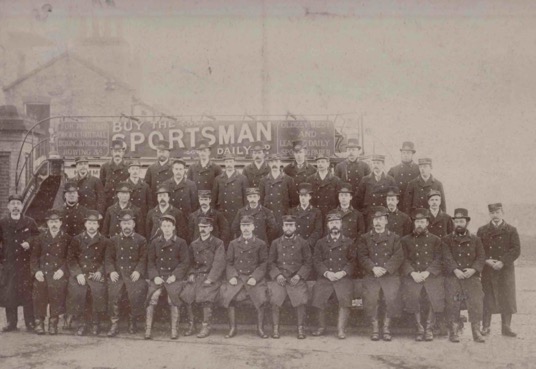
A superb line up of LUTL staff at what is probably, though not certainly, the former Chiswick depot of the defunct WMTCo — photo undated, but given the brand-new tramcar in the background, of a type ordered by the WMTCo but delivered into LUTL ownership, probably taken in early 1895. Author's Collection.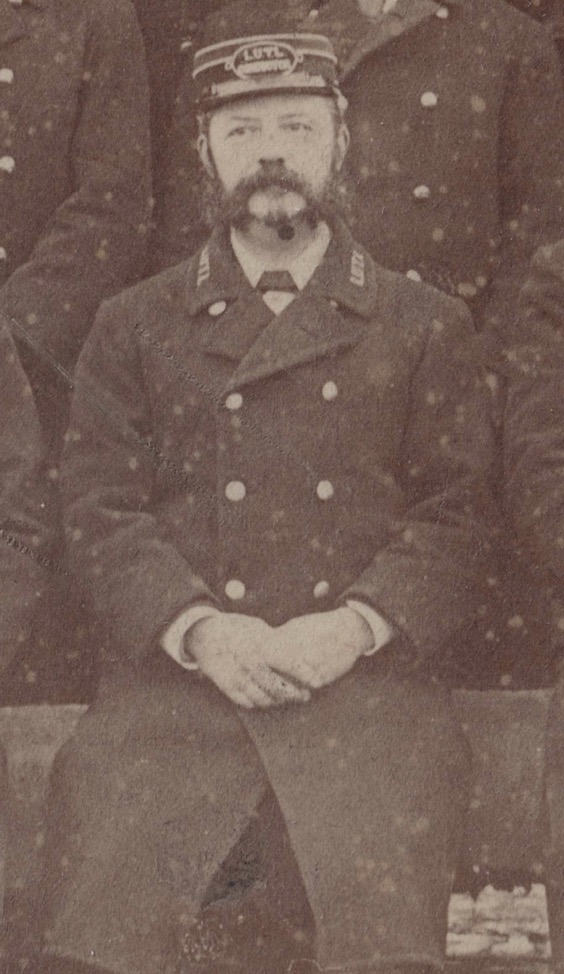
An enlargement of the above photograph showing one of the conductors. He is wearing a smart, double-breasted overcoat with 'L U T L' initials on each collar, along with a heavily piped, kepi-style cap bearing a large oval cap badge; both the collars and the cap badge would seem to be embroidered.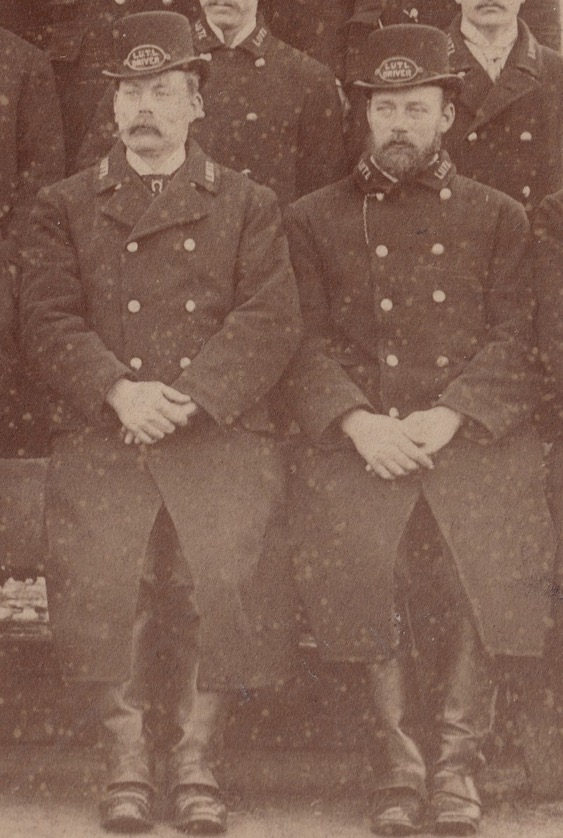
Another enlargement of the above photograph, this time showing two horsecar drivers. They are wearing the same style of overcoat as the conductor, but with a tall coachman's hats rather than a kepis. The coachman's hat bore the same style of embroidered cap badge as the conductor, but with 'DRIVER' rather than 'CONDUCTOR' embroidered upon it.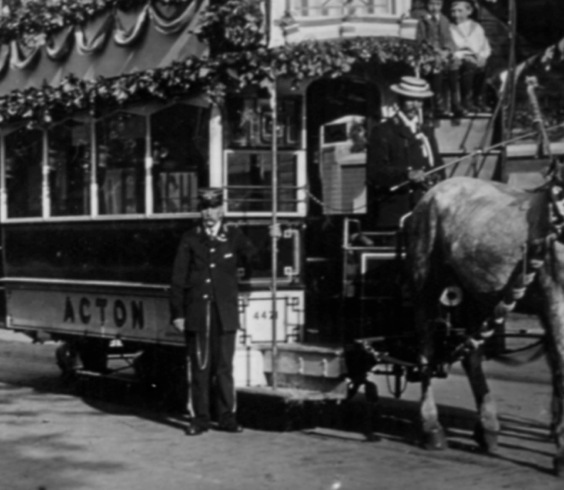
A conductor and a driver pose with their horsecar on the occasion of Queen Victoria's jubilee in 1897. The conductor is wearing a kepi-style cap and a single-breasted jacket. Photo courtesy of the Tramways and Light Railway Society, with thanks to David Voice.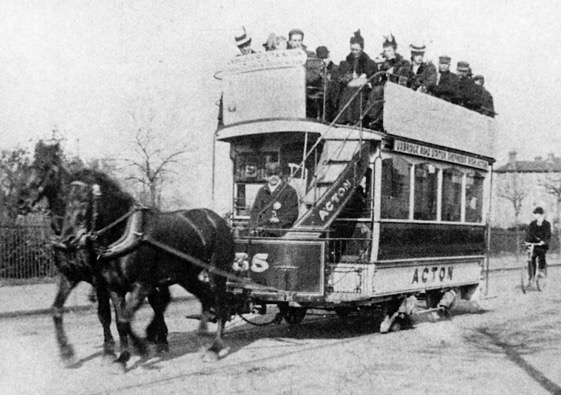
LUT Horsecar No 36 on the Uxbridge Road to Acton route — photo undated, but probably taken around the turn of the century. The driver is wearing a kepi-style cap and a licence badge. Photo courtesy of the Tramways and Light Railway Society, with thanks to David Voice.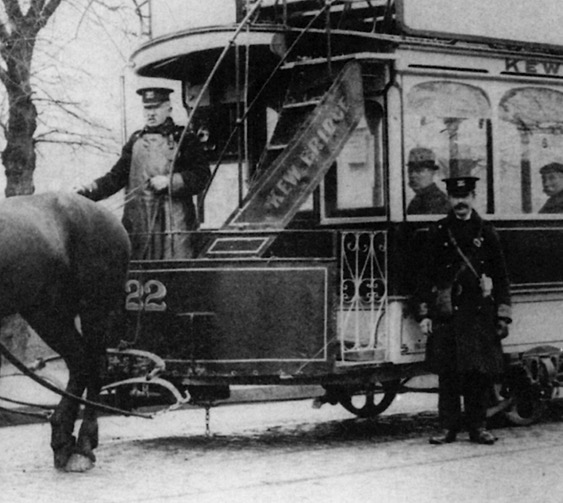
A driver and a conductor pose for the camera with the LUT's last horse car (No 22), which was used to work its isolated Kew to Richmond line. The photo is undated, but was almost certainly taken in the last years of operation (1910 to 1912). Both men are wearing tensioned-crown caps bearing the 1909 coat of arms cap badge. Photo courtesy of the Tramways and Light Railway Society, with thanks to David Voice.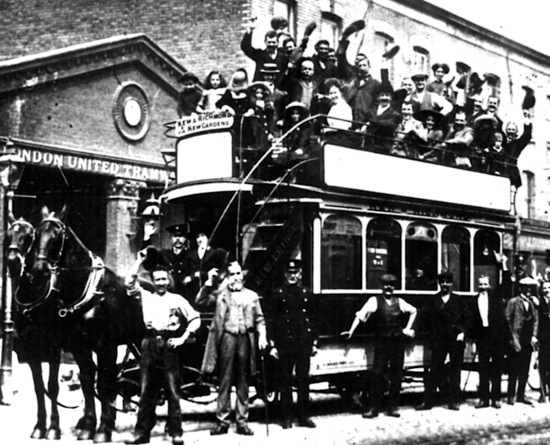
Another shot of Horsecar No 22, this time taken outside Richmond Depot, very possibly on the last day of operation (20th April 1912). Both crewmen are wearing double-breasted, lancer-style tunics identical to those worn by their electric tramcar counterparts. Photo courtesy of the Tramways and Light Railway Society, with thanks to David Voice.
Motormen and conductors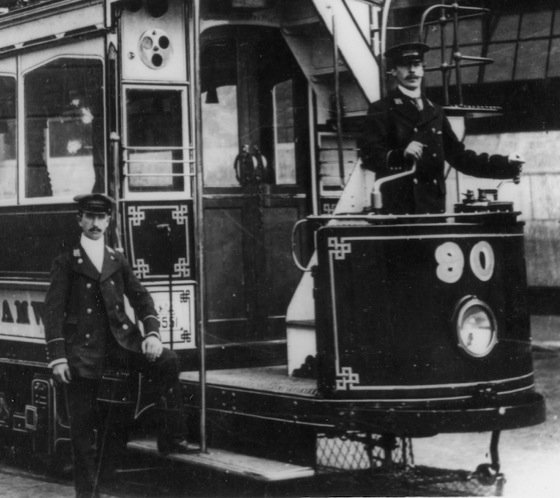
A conductor and a motorman pose for the camera at Chiswick Depot with what is evidently a brand-new vehicle; photograph almost certainly taken just prior to the inauguration of electric services in 1901. Author's Collection.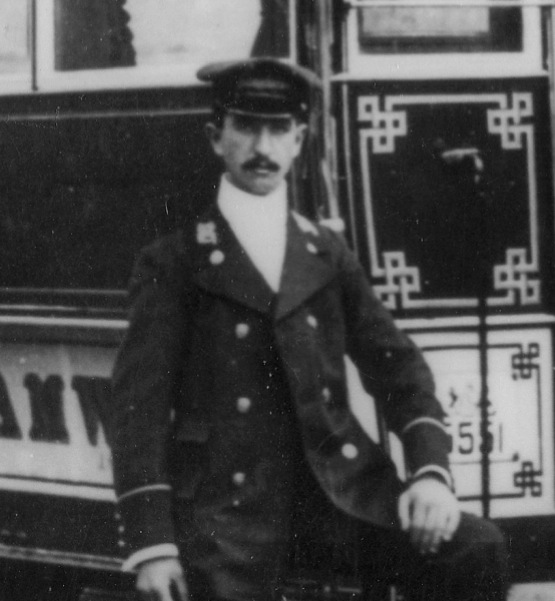
An enlargement of the above photograph showing the conductor. The badges on the collars appear to be embroidered initials, either 'LUET' or 'LUTL'.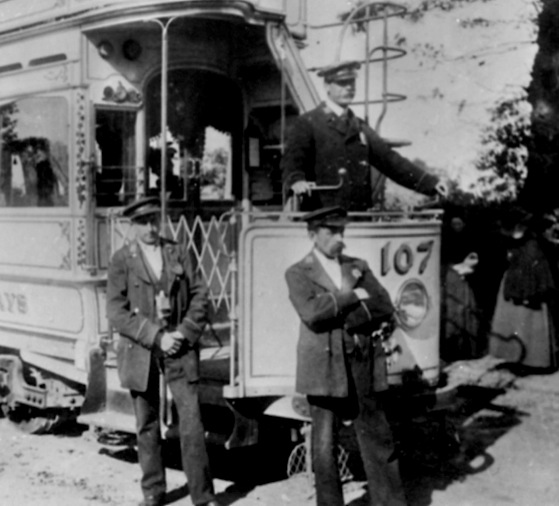
A conductor, a motorman and another uniformed employee (possibly an inspector) pose with Tramcar No 107 on the Uxbridge Road route. Photo courtesy of the Tramways and Light Railway Society, with thanks to David Voice.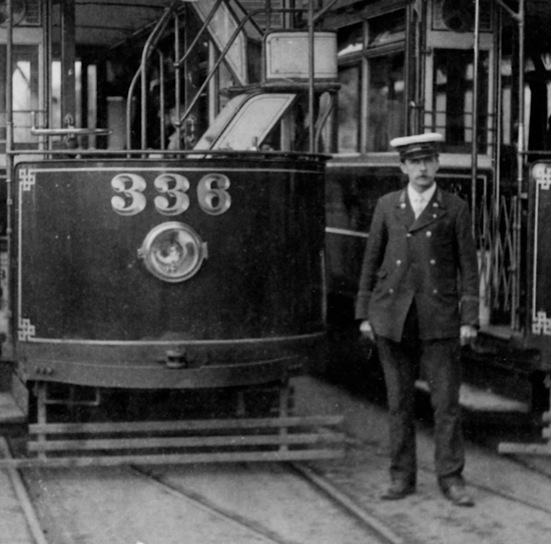
A motorman stands next to Tramcar No 336 outside the Duke of Wellington pub on the New Malden line — photo dated 1906. Photo courtesy of the Tramways and Light Railway Society, with thanks to David Voice.
The crew of Tramcar No 150 pose for the cameraman — photo undated, but probably taken in the mid-to-late Edwardian era. Whilst the jackets are the same double-breasted style as previously used, there is no sign of the embroidered collar badges, suggesting that they were dispensed with at some point. Additionally, both mens' caps appear to bear a cap badge that is far too small to be of the large elaborate type introduced around 1909 (see later).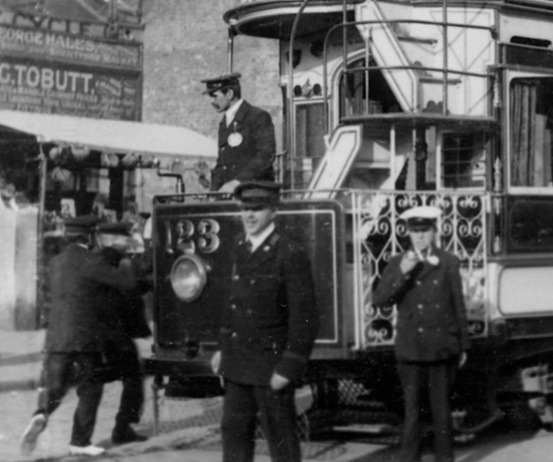
A motorman watches whilst two passengers rush to board a Hanwell-bound car whilst an inspector or regulator (in all probability) oversees proceedings — photo undated, but probably taken in the mid-to-late Edwardian era. Note the latter's hat and cuff bands, which appear to be in a different material (and possibly colour) than the main body of the jacket. The motorman and conductor's jacket collars are now plain. Photo courtesy of the Tramways and Light Railway Society, with thanks to David Voice. 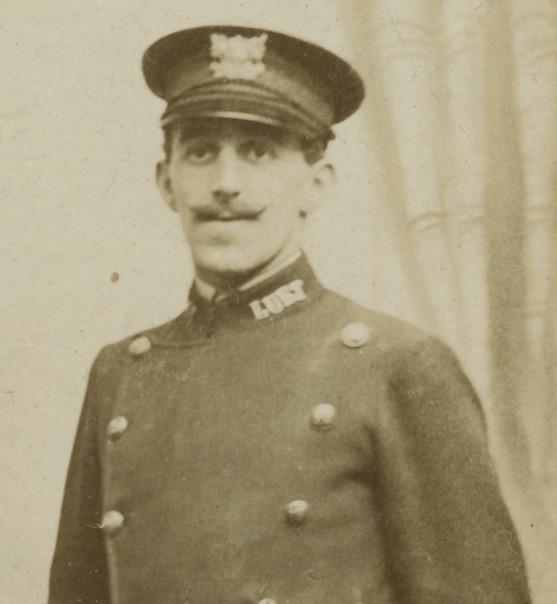
LUET conductor Charles Richards, photographed around 1910 when he would have been circa 27 years old; he was probably living at 25 Luther Road, Teddington, which is where he was recorded in the census of the following year. The collar initials of the new lancer-style uniform are easily made out, as is the new-style of cap badge — based on the arms of London — which is in fact missing the wing on the top (see below), presumably having been accidentally snapped off. Photo courtesy of the Rose Family Collection.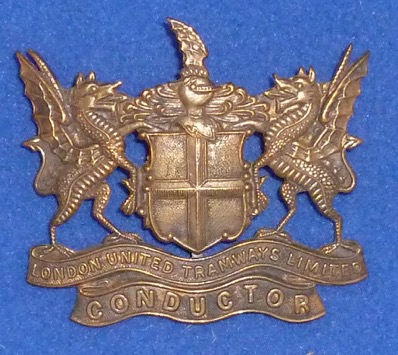
LUT conductor cap badge (c1909 to c1920) — brass. Author's Collection.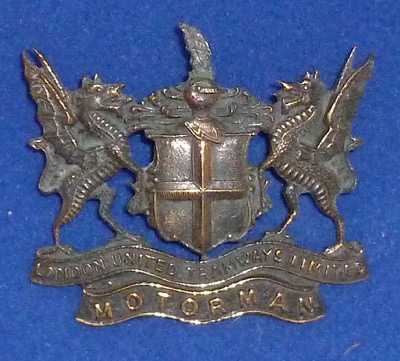
LUT motorman cap badge (c1909-c1920) — brass. Author's Collection.
A studio portrait, which is believed to be of an LUET motorman, and which clearly shows that the system initials were carried on both collars — photo undated, but probably taken in the late-Edwardian era.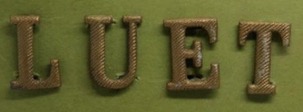
LUET collar initials. Photo courtesy of London Transport Auctions.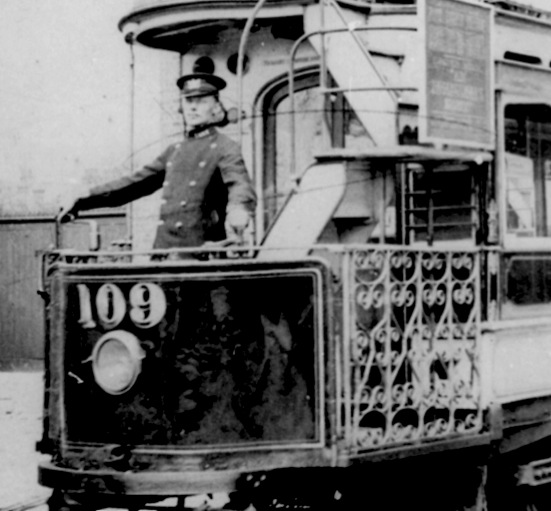
An LUT motorman at the controls of Tramcar No 109 — photo undated, but probably taken during the late-Edwardian era. Photo courtesy of the Tramways and Light Railway Society, with thanks to David Voice.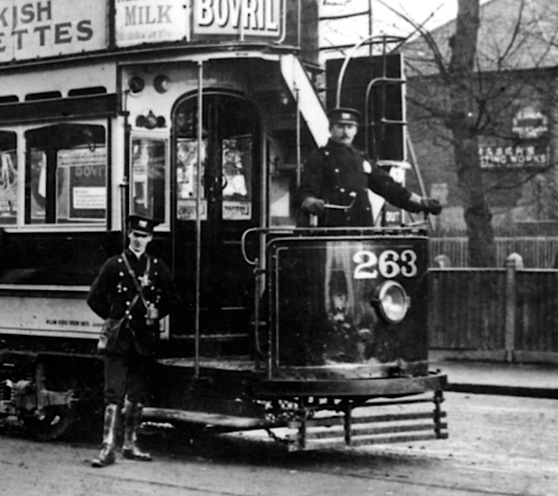
A conductor and a motorman pose with Tramcar No 263 in late Edwardian-era uniforms at the Tooting Terminus. Photo courtesy of the Tramways and Light Railway Society, with thanks to David Voice.
Class U Tramcar No 171 with a motorman and a conductor — photo possibly taken shortly before the Great War. Both men are wearing double-breasted lancer-style greatcoats, and caps bearing the 1909 cap badge. Photo courtesy of the London County Council Tramways Trust.
Another shot of a tramcar crew, this time of Tramcar No 23 — photo probably taken between 1910 and 1914. The fact that the conductor lacks a licence badge and ticket punch suggests that the photograph was taken in a depot, or alternatively, that the individual concerned is not a conductor but a more senior member of staff. Whichever the case, both men's lancer-style greatcoats are completely devoid of insignia. 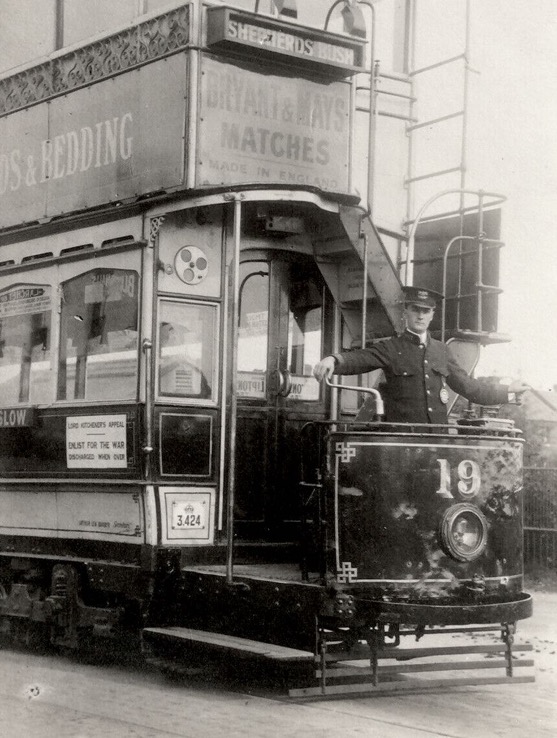
A motorman at the controls of Tramcar No 19, photograph taken during the Great War. He is wearing a single-breasted jacket with two breast pockets and stand-up collars.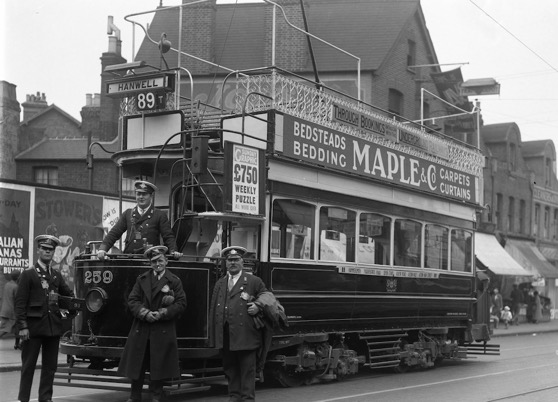
Two crews pose for the camera of H Nicol with a very smartly turned out Tramcar No 259 on a No 89 service to Hanwell — photo probably taken in 1929. Image courtesy of the National Tramway Museum.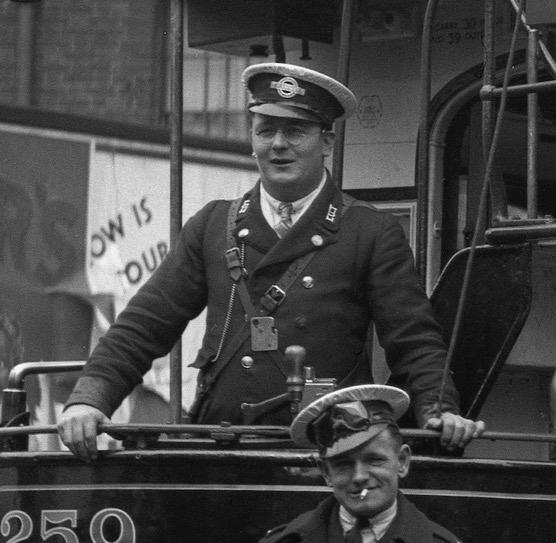
An enlargement of the above photograph showing one of the conductors, and a rather stylish motorman, complete with goggles. The conductor's Underground Group 'bullseye' cap badge and one-piece 'LUT' collar badges are easily seen.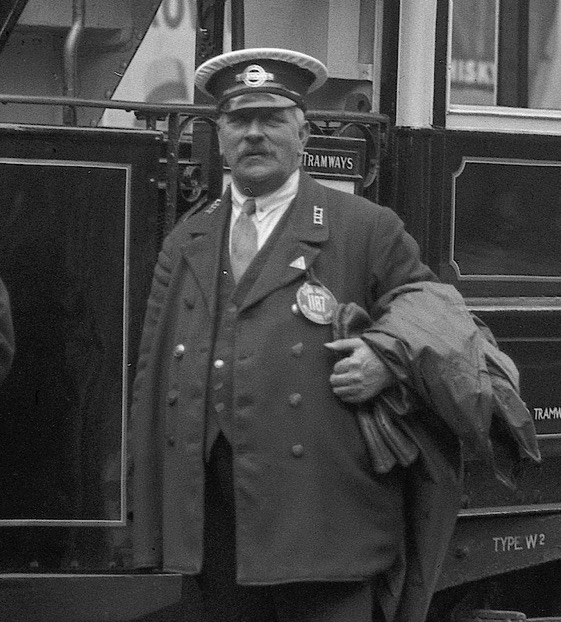
Another blow-up of the above photograph, this time showing the other motorman, Metropolitan Police 'Stage Driver Mechanical Power' badge holder No 1187.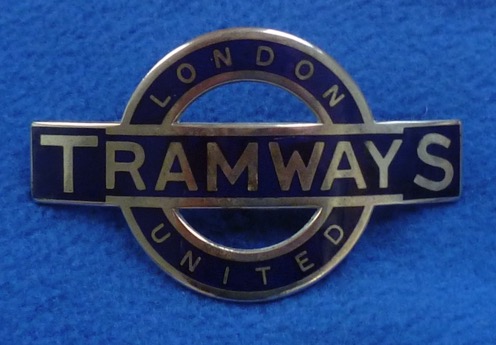
London United Tramways 'bullseye' cap badge (c1920 to 1933) — nickel and blue enamel.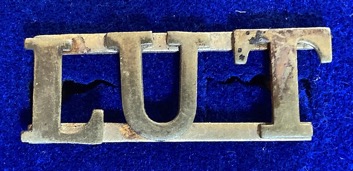
LUT one-piece collar badge (c1920-1933) — brass. Author's Collection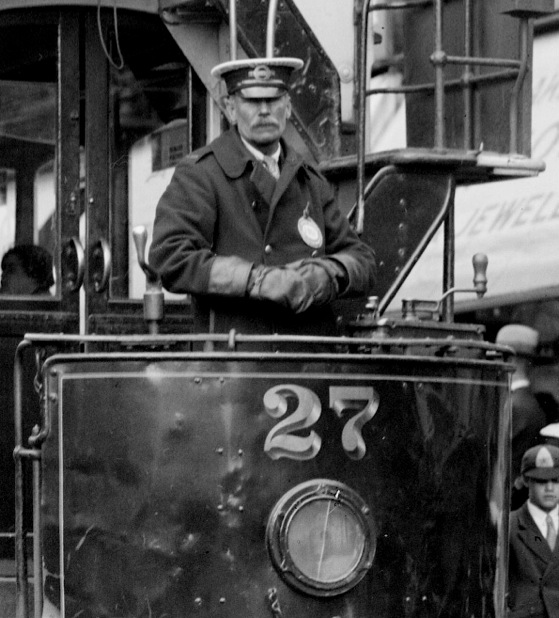
A London United Tramways motorman poses for the camera in Boston Road, Hanwell — photo undated, but probably taken in the late 1920s or early 1930s. The later Underground Group 'bullseye' cap badge, as well as the ubiquitous Mechanical Power licence badge, are clear to see. Photographer, H Nichol, with thanks to the National Tramway Museum.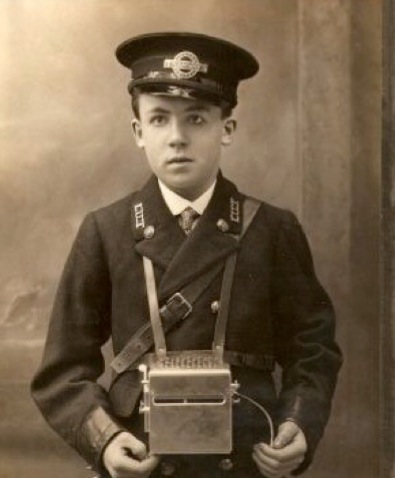
LUT ticket collector (?) — photo undated, but probably taken in the early-to-mid 1920s. The one-piece LUT collar initials are clearly seen.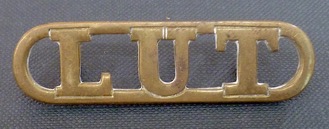
LUT collar/lapel initials badge with lozenge-shaped surround — brass. It is unclear by which grades this was worn. Author's Collection.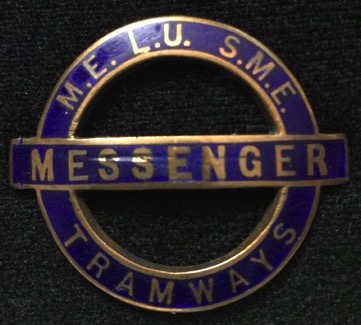
Underground Group 'Messenger' cap badge — nickel and blue enamel (c1920 to 1933). Note that in contrast to the Official's cap badge below, each of the constituent tramway initials misses the 'T' off. Photo courtesy of Matt Lodge.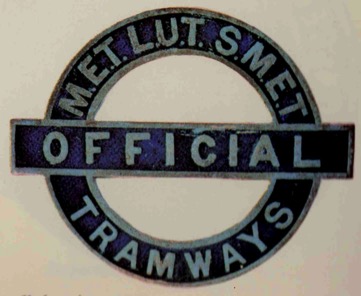
Official's badge — nickel, (with acknowledgement to 'Wheels of London', Times Newspapers Ltd, 1972). Worn from c1920 to 1933.
General 'Underground Group' Tramways cap badge — nickel (c1920 to 1933). Author's Collection.
General 'Underground Group' Tramways collar badge — brass (c1920 to 1933). Author's Collection.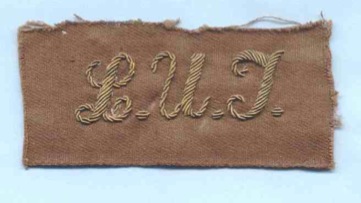
Embroidered LUT initials, probably from a summer dust jacket. With thanks to Stephen Howarth.
Senior staff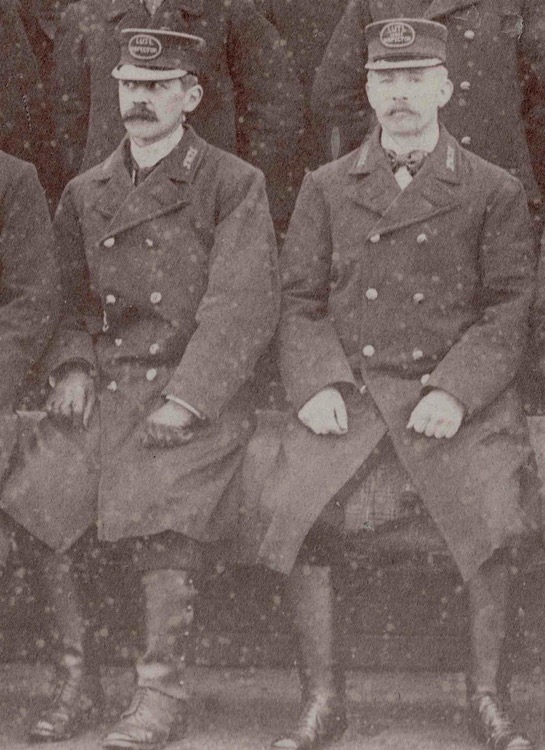
An enlargement of the c1895 Chiswick staff photograph above showing two of the senior staff, an inspector (on the left) and a chief inspector (probably) on the right. Both men are wearing the standard overcoat and gaiters, but with kepis bearing their respective grades. The fact that their shirts and ties are visible suggests that any jackets worn did not have high collars.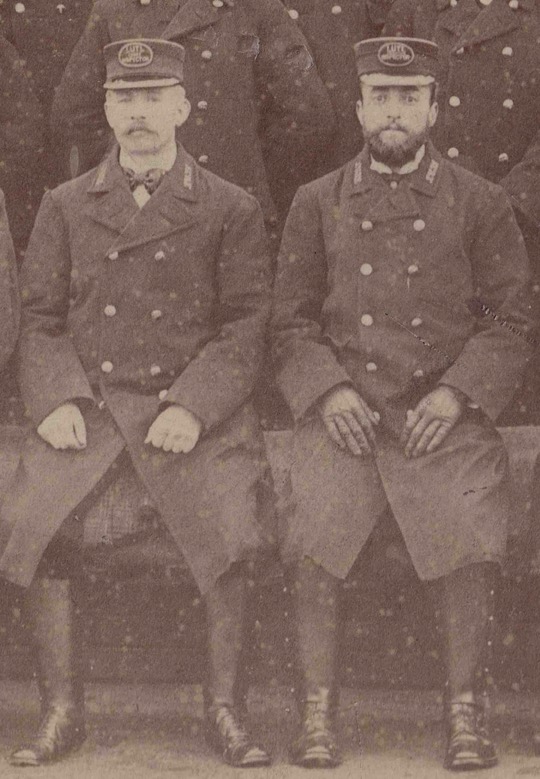
Another blow-up of the c1895 Chiswick staff photo, showing two more senior inspectors.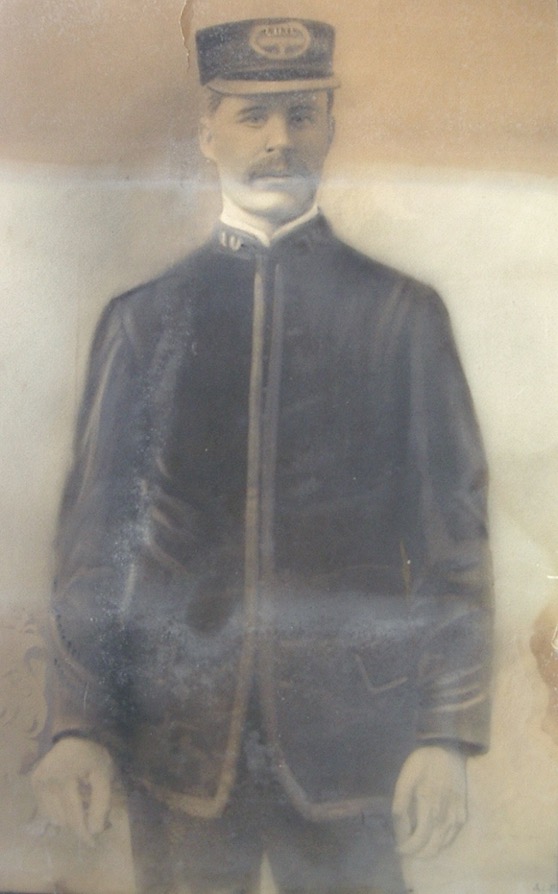
A studio portrait of Inspector Albert Yates, which though heavily touched up, is believed to show him in an LUTL uniform in the late 1890s. He was listed as an inspector in Bristol in the 1891 census, presumably working for the Bristol Tramways and Carriage Company, and again in 1901 in Sunderland, working for Sunderland Corporation Tramways. He is believed to have worked for the LUTL around 1897/8, which is presumably when the photo was taken. He appears to be wearing fairly standard tramway inspector garb, with cloth cap badge bearing embroidered system initials — L U T L — and his grade. Photo courtesy of Albert's great grandson, Peter Thompson.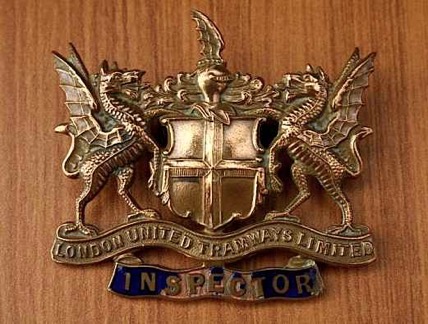
Inspector's cap badge — brass (c1909 to c1920). With thanks to the LCC Tramways Trust Collection.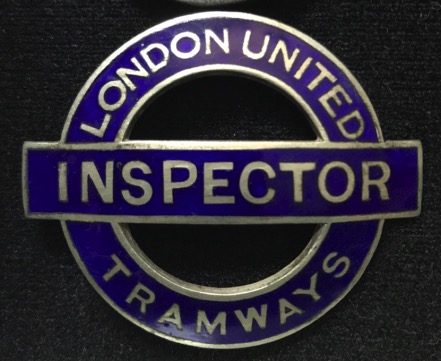
Inspector's cap badge — nickel and blue enamel — worn from c1920 until the creation of the London Passenger Transport Board in 1933. Photo courtesy of Matt Lodge.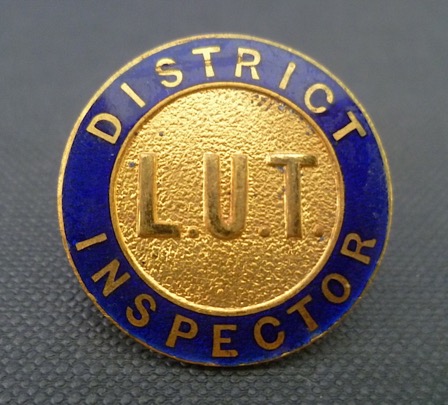
District Inspector cap badge — brass and blue enamel (c1920-1933). Author's Collection.
Female staff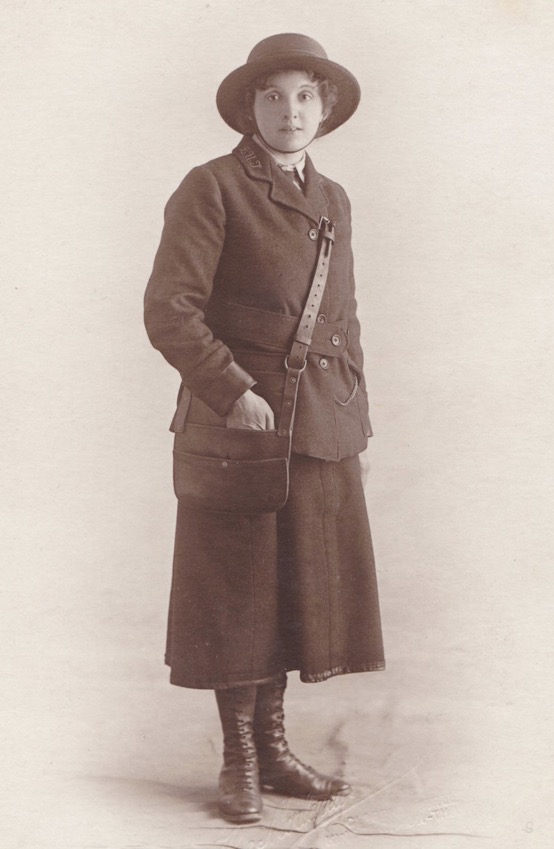
A rare studio portrait of a London United Tramways Great War tram conductress. Photo courtesy of the Geoff Caulton Collection.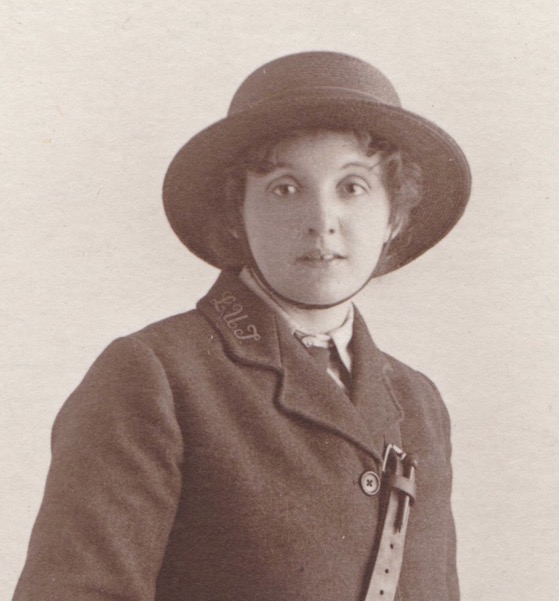
An enlargement of the above photograph showing details of the uniform. The embroidered 'LUT' system initials on the collar are clear to see, as are the plain jacket buttons. The situation with respect to a cap badge is less clear, as if one is being worn, it is unfortunately obscured by the brim of the subject's bonnet.